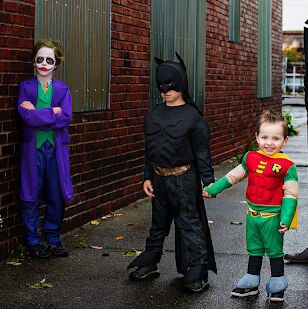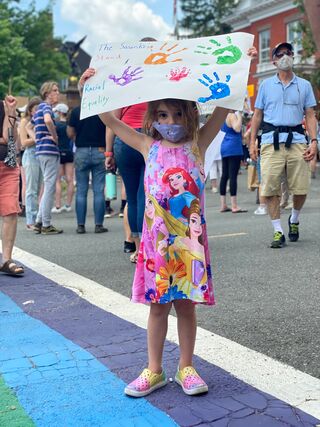
Unconscious
Are Kids Really Afraid of Masks?
Some reflections on faces and masks: considerations from a pandemic.
Posted October 30, 2020 Reviewed by Lybi Ma
Very small children are afraid of clowns, and even smaller ones balk when they first encounter people with beards or even glasses. These things are related to the proverbial phenomenon of stranger anxiety (common in the first year of life) since anything that distorts or conceals the familiar blueprint of a human face seems to signal a primal strangeness.
From an evolutionary perspective this makes sense, and human babies can remind us that we are innately wired to respond to the most basic configuration of the human face; actually it turns out the best-selling crib mobiles are the ones whose design follows a schematic that corresponds to eyes, nose, mouth, in that order, not Picasso style. But though it’s our mouths that smile, it’s the eyes that seal the relational deal. Even peekaboo is all about the eyes; you can’t do peekaboo if you leave the eyes out. We have all had the experience of a baby solemnly locking eyes with us or visually tracking us with the laser-like precision of a searchlight, and it’s observable that babies don’t seem to blink as much as adults. This could be because they are preprogrammed to stay in touch via their eyes, so in the earliest phases of development, vigilance is the name of the game. Eyes are said to be the windows of the soul, but they are also the beacon infants use to orient themselves, particularly before they can move around and talk.
Crawling babies also rely on eye contact for social reference or to size up their next move. Think of the famous visual cliff that babies will cross in response to a mother’s encouraging gaze, as opposed to the light socket they veer away from when mommy’s eyes signal disapproval. Interestingly studies have shown that autistic children have been found not to fixate on eyes, and instead focus on the mouth, since the very intensity of eye contact can be overwhelming to some who are on the spectrum.
What happens to little ones if the familiar arrangement of a human face is rendered unpredictable? We have some hints that it can be very disturbing. Some of us have witnessed our children being terrorized by the specter of clowns. Try taking a two-year-old to a birthday party featuring a clown: from a toddler’s perspective, it might as well be Stephen King’s creepy clown emerging from a fetid sewer. A young patient once explained what it is about clowns and their concealing makeup that sends little ones running for the hills: “You cannot tell what they are thinking.”
There is a psychological experiment designed to simulate the situation of maternal depression. Typically expressive mothers are asked to make their faces go blank for about a minute. In videos of the “Still Face Experiment” not only are the mother’s not smiling, but most chilling to behold, their eyes look dead. Inevitably their babies become agitated and frightened almost instantaneously.
We know that masks can be powerful and often scary signifiers, denoting criminality (as in the bank robber or the cat burglar) hidden identities, or mysterious alter egos (think the Lone Ranger, Batman, or the Phantom of the Opera; and at the most sinister end of the spectrum, picture the iconically horrifying sight of the ski-masked serial killer, bounty hunter or terrorist). Then there is the totemic power of the mask in native cultures, whose purpose is to scare off enemies or invoke the forces of nature. Just walk into any gallery of a natural history museum to see the full panoply of masks whose very design cannot help but evoke awe in a spectator.
Pretty much all of the above masks derive their power from obscuring the eyes so that the wearer can see without being fully seen. Covering up the whites of the eyes, as it were, may be the secret sauce that empowers the wearer and intimidates the viewer.
Well, something huge has happened in the world of reassuring facial configurations or so it would seem. We have a pandemic and all of sudden masks became ubiquitous. Did you ever think a mask would be de rigeur when leaving the house? Wallet? Check. Keys? Check. Mask? Check. Suddenly all of us are being bombarded with faces that are shrouded from nose to chin and ours are too. At least the eyes preside reassuringly over the situation; yet what is this odd new normal like, especially for the youngest among us who put so much stock in faces? It seems on the face of it (excuse the pun) complicated.

The masks that are everywhere now are those that cover the middle and lower parts of the face, unlike the tribal masks or criminal masks or “who is that masked man?” masks. The ones we have now spare the eyes and cover the nose and mouth, and may have their own unconscious resonance: something different. On the one hand, the masks that have become a staple of our daily life (and can even be purchased at Staples) do not seem to be frightening for babies or young children; counterintuitive perhaps, since one might think a mask where you can’t see the expressions on the face, not to mention a smile, might be the most uncanny.
But as noted above, the covering up of the upper part of the face, including the eyes, seems to create the scariest vibes.
I have not heard of or seen even one child of any age being phased by masked faces everywhere, and children only object since they don’t like the way masks feel (who does really?) not how they look. On the other hand, some adults object to mask-wearing as a violation of personal freedom, not simply because they are indisputably annoying and uncomfortable. There are clearly multiple and complex reasons why mask-wearing might feel offensive, but perhaps some of those are triggered by unpleasant (and likely unconscious) associations connected with the lower part of the face.
Perhaps when the eyes are hidden, it signifies that “I know who I am but you don’t”, thus, “the power is in my court. I can look out but you cannot look in”, akin to black windows on a limo or a one-way mirror. But maybe when the nose and mouth are covered it signals something less enthralling, less awe-inspiring, even humiliating perhaps. What though? Muzzling of self-expression? Being gagged? Or else something even worse: contagion? Putrefaction? Cooties? Stench? Corpses and autopsies? Covering the nose universally signals repulsion, and covering the mouth could suggest a susceptibility to being invaded or inhabited by microbial intruders (well actually that is the issue).
At the very least the current masks seem to conjure up images of surgeons and bodily illness. The pandemic’s signature facial masks, even when they are whimsical or colorful may pull some of us toward a chain of associations that leads all the way to the graveyard and the morgue, accentuating our mortality and fragility. And of course that is why we wear the masks in the first place: to ward off death. Fortunately, death is a concept that is developmentally acquired, so the youngest among us have not figured that one out yet, thus the aesthetics don’t automatically take them there.

Interestingly, some experts think the masks we wear now function a little like a DIY vaccine: they prevent most aerosols from getting through, but maybe those few that sneak by may confer a little immunity. Actually, these seemingly lowly and lower-down masks have a superpower all their own. If we keep them on, we will be unlikely to require a death mask.



